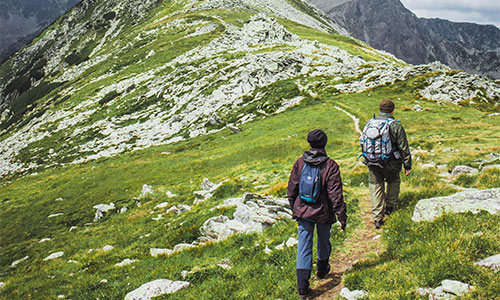Thru-Hiking America's Legendary Trails: A Comprehensive Guide
Author
17th November 2023
by Charlene Gregory
- Many adventurers, whether they are avid backpackers, readers, or moviegoers, have contemplated the thrilling experience of thru-hiking one of America's iconic trails: the Appalachian Trail (A.T.) or the Pacific Crest Trail (PCT). This blog aims to shed light on the world of thru-hiking, providing an informative overview of key topics that every aspiring thru-hiker should consider
- What is Thru-Hiking?
- A thru-hike is a remarkable end-to-end backpacking journey along a long-distance trail, such as the A.T. or the PCT. The A.T. stretches over 2,100 miles from Georgia to Maine, while the PCT covers more than 2,600 miles from Mexico to Canada.

- Variations of Classic Thru-Hikes:
- For those unable to commit to months of thru-hiking, alternative options have emerged. While some purists may argue that these variations are not true thru-hikes, the core essence remains the same – pushing oneself to overcome challenges.
- Pick a Shorter Trail: Consider trails like the Superior Hiking Trail, meandering over 300 miles along Lake Superior's shoreline, requiring a commitment of about a month.
- Section Hiking: Opt for a single section of a classic thru trail, such as the 211-mile John Muir Trail (a part of the PCT). This approach can be spread over multiple hiking seasons.
- Flip Flop: Complete a classic thru-hike in a non-linear way, starting somewhere in the middle and hiking sections in both directions. This approach allows for a unique experience and avoids the crowds.
- Thru-Hike Challenges:
- Embarking on a thru-hike presents numerous challenges that test both mental and physical strength. Solo-thru-hikers may encounter moments of loneliness and self-doubt, questioning their initial motivation. However, these challenges can be overcome with proper strategies and mental preparation:

- Mental Challenges:
- Embrace solitude and learn to appreciate your own company.
- Understand that moments of self-doubt are normal during such a significant journey.
- Set intermediate goals and celebrate achievements along the way.
- Physical Challenges:
- Train and prepare your body for the rigorous demands of thru-hiking.
- Acquire first-aid knowledge and ensure your first-aid kit is well-equipped.
- Financial Challenges:
- Thru-hiking entails leaving work for an extended period, necessitating financial planning.
- Research and budget for gear and food expenses, which can vary significantly based on personal choices.
- The Planning Process:
- Thorough planning is crucial for a successful thru-hike. Begin the planning process at least eight months before your intended start date, considering the following key aspects:
- Itinerary:
- Decide where and when to start and finish, taking weather conditions into account.
- Research and acquire necessary permits well in advance.
- Plan transportation to and from the trailheads.
- Determine daily mileage and potential resupply stops
- Food and Water:
- Strategize food choices based on calorie needs, weight, and availability.
- Plan water sources carefully, especially in arid regions, and consider water treatment options
- The Thru-Hiking Community:
- One of the most rewarding aspects of thru-hiking is the close-knit community that forms along the trail. Fellow thru-hikers become a supportive family, and trail angels offer essential aid to hikers. These kind-hearted individuals provide help to thru-hikers in various ways, from offering rides to providing food and shelter. Show appreciation for their assistance by making modest donations to support their services for other hikers.
- Thru-Hiker Speak:
- The thru-hiking community has its own language, and familiarising yourself with these terms can enhance your experience on the trail:
- Hike Your Own Hike: Embrace individuality and respect others' hiking styles.
- Bounce Box: A resupply box sent ahead to lighten your load.
- Trail Magic: Unexpected help or acts of kindness along the journey.
- Zero Day: A day without gaining mileage toward the trail's end, often used for rest and resupply.
Author
17th November 2023
by Charlene Gregory
More from Charlene Gregory
Follow Outdoor Look
Categories
- Sport (28)
- Product Reviews (3)
- Team Outdoor Look (7)
- Mike Wild (2)
- Mike Payton (2)
- Suse Hammond-Pears (3)
- Snowboarding (12)
- Latest Offers (105)
- Shop Talk (1)
- Competitions (7)
- Walking (413)
- Lifestyle Fashion (8)
- Travel (86)
- Kit Guides (176)
- Workwear Clothing (6)
- Safety Workwear (4)
- Health/Fitness (289)
- Skiing (91)
- Great Outdoors (1316)
- Cycling (92)
Archives
- January 2025
- December 2024
- November 2024
- October 2024
- September 2024
- August 2024
- July 2024
- June 2024
- May 2024
- April 2024
- March 2024
- February 2024
- January 2024
- December 2023
- November 2023
- October 2023
- September 2023
- August 2023
- July 2023
- June 2023
- May 2023
- April 2023
- March 2023
- February 2023
- January 2023
- December 2022
- November 2022
- October 2022
- September 2022
- August 2022
- July 2022
- June 2022
- May 2022
- April 2022
- March 2022
- February 2022
- January 2022
- December 2021
- November 2021
- October 2021
- September 2021
- August 2021
- July 2021
- June 2021
- May 2021
- April 2021
- March 2021
- February 2021
- January 2021
- December 2020
- November 2020
- October 2020
- September 2020
- August 2020
- July 2020
- June 2020
- May 2020
- April 2020
- March 2020
- February 2020
- January 2020
- December 2019
- November 2019
- October 2019
- September 2019
- August 2019
- July 2019
- June 2019
- May 2019
- April 2019
- March 2019
- February 2019
- January 2019
- December 2018
- November 2018
- October 2018
- September 2018
- August 2018
- July 2018
- June 2018
- May 2018
- April 2018
- March 2018
- February 2018
- January 2018
- December 2017
- November 2017
- October 2017
- September 2017
- August 2017
- July 2017
- June 2017
- May 2017
- April 2017
- March 2017
- February 2017
- January 2017
- December 2016
- November 2016
- October 2016
- September 2016
- August 2016
- July 2016
- June 2016
- May 2016
- April 2016
- March 2016
- February 2016
- January 2016
- December 2015
- November 2015
- October 2015
- September 2015
- August 2015
- July 2015
- June 2015
- May 2015
- April 2015
- March 2015
- February 2015
- January 2015
- December 2014
- November 2014
- October 2014
- September 2014
- August 2014
- July 2014
- June 2014
- May 2014
- April 2014
- March 2014
- February 2014
- January 2014
- December 2013
- November 2013
- October 2013
- September 2013
- August 2013
- July 2013
- June 2013
- May 2013
- April 2013
- March 2013
- February 2013
- January 2013
- December 2012
- November 2012
- October 2012
- September 2012
- August 2012
- July 2012
- June 2012
- May 2012
- April 2012
- March 2012
- February 2012
- January 2012
- December 2011
- November 2011
- October 2011
- September 2011
- August 2011
- May 2010
- April 2010
- March 2010
- February 2010
- January 2010
- November 2009
- October 2009
- September 2009


Submit a Comment